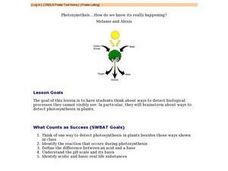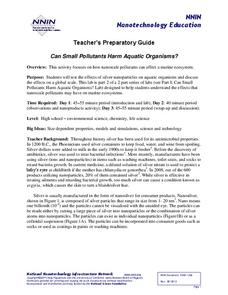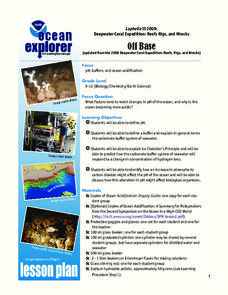Curated OER
Activity #17 Co2 From Alka Seltzer
Students observe what occurs when Alka Seltzer tablets are added to water. They explain why water stays in the jar when it is above the surface of the water. Pupils test for the presence of carbon dioxide by conduting the match test.
Curated OER
Molecular Modeling Activity
Students work together to explain the VSEPR theory and how it relates to molecules. They name electron pairs that can surround the central atom of an organism. They discuss the factors that determine the polarity of a molecule as well.
Curated OER
How is the Strength of an Acid Determined?
Students study acids and how they can be measured. In this acid lesson plan students distinguish the properties that create strong and weak electrolytes.
Curated OER
Observing the Effect of a Change in Conditions on a System at Equilibrium by Applying Le Chatelier's Principle
Students describe the Le Chatelier Principle. They participate in an experiment in which they observe the changes in an equilibrium system. They answer discussion questions to end the lesson.
Curated OER
# 02 The Aspirin Shelf-Life Scenario
Students work for a company that produces acetylaslicylic acid, aspirin. They have been assigned the task of determining if different packaging materials and/or environmental storage procedures can increase the shelf-life of the product.
Curated OER
Photosynethsis....How do we know it's really happening? - Biology Teaching Thesis
Students think of one way to detect photosynthesis in plants besides those ways shown in class. They identify the reaction that occurs during photosynthesis. Students define the difference between an acid and a base. They identify acidic...
NOAA
Off Base
How does carbon dioxide affect the world's oceans? The final installment in a series of six lessons has pupils research ocean acidification, then conduct an experiment to witness the delicate balance that exists in our seas. Materials...
Cornell University
What Happens When We Excite Atoms and Molecules?
Excited atoms lead to exciting lessons! Learners use heat and light to excite both atoms and molecules. They display their learning in the form of Bohr models depicting the excited state of the atoms.
National Nanotechnology Infrastructure Network
Can Small Pollutants Harm Aquatic Organisms?
Nanoparticles have toxic effects on plant and animal life—even though you can't see them. The second lesson of a two-part series has young scientists conduct an experiment that exposes plant and animals to nanoparticle pollutants. They...
Curated OER
Devising a Set of Experiments to Test Water for Dissolved Substances
Students work together to test water samples for pollutants. They design data tables to collect and record their observations. They complete discussion questions to end the lesson.
Curated OER
Activity #8 Which State Are You In?
Young scholars define, give similarites and differences between solids, liquids, and gases. They compare and contrast a solid, liquid and gas in terms of shape, volume, compressibility, diffusion and density. Pupils classigy common...
Curated OER
Diffusion through Membranes
Students identify diffusion and its processes through experimentation and calculations. They also use a CBL and conductivity probe to measure the conductivity of various solutions and study the effect of concentration gradients on the...
Curated OER
Introduction to the Mole
Students are introduced to the mole concept using a discovery-based method. Lesson includes activities with candy that allow students to discover the rules for mole-item, item-mole, mole-mass, and mass-mole conversions.
Curated OER
Rechargeable Batteries
High schoolers explore how rechargeable batteries work by conducting a series of experiments. In this physics lesson, students discuss the benefits of using rechargeable batteries over disposable ones. They build their own battery...
Curated OER
Water Resource Engineering
Students examine solubility and the significance of water. In this aqueous solution instructional activity students complete a lab activity on soil profiles.
Curated OER
Chemical Composition of American Coins
Students investigate the chemical composition of pennies dated 1983 or later. For this chemical composition of American coins lesson plan, students scratch the surface of the penny to expose the zinc core. They put the penny in...
Curated OER
Off Base
Young scholars explain the Chatelier's Principle. In this pH lesson, students identify factors that resist changes in pH of the ocean and why the ocean is becoming more acidic.
Curated OER
H2O2 Decomposition Lab II
Students conduct an oxidation experiment in which they must determine how much hydrogen peroxide (H2O2) is actually in a store-bought solution of H2O2.
Curated OER
Corrosion/Conservation/Preservation
Young scholars examine the reasons why metal corrodes in regard to metal artifacts. In groups, they discover the affects of salt water on metal and compare the type of corrosion found on iron. They also research the types of metal...
Curated OER
Molecular Architecture
High schoolers cuminate their study of molecular structure and bonding with this activity.
Curated OER
Water Quality Tests Explained
Learners define all eight water quality parameters and list at list one source for each of the eight water quality parameters. They determine how each of the eight parameters affect river ecosystems.
Curated OER
Reading The Periodic Table
Eighth graders examine the Periodic Table. In this science lesson plan, 8th graders categorize a group of shells and unknown elements using different characteristics as they read and interpret the Periodic Table.
Curated OER
Phosphate Testing Contract
Students examine how to prepare an experimental procedure. In this scientific method lesson students conduct an investigation on phosphate.
Curated OER
Properties of Logarithmic Functions
Students solve exponential functions. In this algebra lesson, students identify the properties of logarithmic and exponential functions. They graph their functions and solve using change of base formula.

























